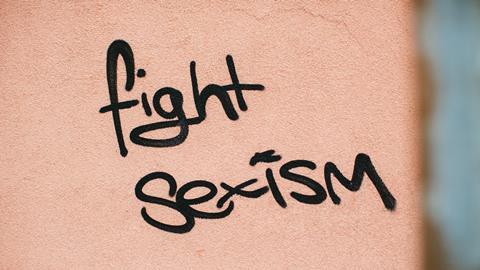Apologist Joel Furches explores women’s place in the Church, both historically and today
Blogger Robert Neilson complains: “The sexism begins at the very beginning of the Bible where man is created first (the implication being as he’s more important). Woman on the other hand is created from a small part of man’s body (his rib) as ‘a help’ for man.”
Feminist Barbara G Walker addresses the Freedom from Religion Foundation with the words: “In Christian history, the real human sacrifices have been women…Women’s bodies, minds and fortunes were sacrificed to that god’s church for many centuries. Women’s legal freedoms, reproductive capacities and intellectual accomplishments continue to be sacrificed to male interests as a result of attitudes promulgated by that god’s church.”
As the world continues to elevate and respect the role of women, disapproval of the Bible’s approach to the sexes and the Church’s attitudes toward women become subjects of distinct scrutiny. Are the two atheist accusations above a fair and accurate critique of the Bible and Christianity or is there more to the story?
Women and ancient laws
In Matthew 22 the following exchange occurs between Jesus and a group of religious leaders. Pay careful attention to this exchange, because much of the remainder of this article will rest on its unfolding argument:
The same day Sadducees came to him…and they asked him a question, saying: “Teacher, Moses said, ‘If a man dies having no children, his brother must marry the widow and raise up offspring for his brother.’ Now there were seven brothers among us. The first married and died, and having no offspring left his wife to his brother. So too the second and third, down to the seventh. After them all, the woman died. In the resurrection, therefore, of the seven, whose wife will she be? For they all had her.”
But Jesus answered them: “You are wrong, because you know neither the Scriptures nor the power of God. For in the resurrection they neither marry nor are given in marriage, but are like angels in heaven.” (Matthew 22:23 – 30)
This passage begins with a reference to a command given by Moses in the very ancient world, some 4,000 years before. In this ancient Jewish law meant to guide the Semitic people in a time when women were little more than property, Moses commands men to marry the widow of their dead brother should that woman be childless when her original husband dies.
This ancient law may seem very primitive to modern eyes when women may marry whomever they please or live unmarried and be perfectly self-sufficient, but at the time the law was given, it served as a form of protection for the woman. A childless widow was in a very poor position in the ancient world, unlikely to find a husband, unable to support herself in a world that did not value her. Being childless was a point of shame for women in that time and place, but also a practical concern as one’s future welfare rested in the hands of one’s children as one aged. She would likely be forced to beg or engage in prostitution to support herself thereafter.
By commanding that her brother-in-law marry and support her, God – lover of the orphan and widow – was giving her the greatest form of protection and security available to a woman during that time.
But, perhaps one will ask, why did God – giver of the law – not command that Jewish society simply give women equal status, rather than working within the convention of the day to protect them? To answer this, let us eavesdrop on another confrontation between Jesus and the Jewish leaders:
And Pharisees came up to him and tested him by asking, “Is it lawful to divorce one’s wife for any cause?” He answered, “Have you not read that he who created them from the beginning made them male and female, and said, ‘Therefore a man shall leave his father and his mother and hold fast to his wife, and the two shall become one flesh’? So they are no longer two but one flesh. What therefore God has joined together, let not man separate.” They said to him, “Why then did Moses command one to give a certificate of divorce and to send her away?” He said to them, “Because of your hardness of heart Moses allowed you to divorce your wives, but from the beginning it was not so. (Matthew 19:3-9 ESV)
The brilliant insight within this passage lies in the word ‘allowed’. These ancient people, living in a world wherein modern ideas of egalitarianism were beyond their very conception, were given laws that would maintain society according to the very limited understanding it held. But that understanding did not remain forever within those limits. By the time Christ arrived, his teachings advanced beyond the limits and permissions provided by Moses to a hardened and immature people.
Jesus, for instance, did the unthinkable with regard to women: he took on women disciples, a number of which are listed in Luke 8. This was a practice without precedent in its day. Further still, when Jesus sat and taught, he allowed his disciple Mary to sit at his feet – a privileged position for the student of a Rabbi (traditionally, Rabbis only trained male students, with their prized pupil sitting at their feet). When Martha challenged this unconventional situation, suggesting that Mary ought to be off doing a woman’s work, Jesus told Martha that Mary had made the better choice to sit and be his student.
Get access to exclusive bonus content & updates: register & sign up to the Premier Unbelievable? newsletter!
Returning to the subject of our original passage from Matthew 22, notice all of the death within that passage. Whether the Sadducees were telling a true story or making something up to stump their foe, the story had one brother after another die, terminating with the death of the woman herself. Death, in the Biblical context, is the consequence of sin. That men and women live and die and are victims of one another’s abuse are all indications of the sinful state of the world. Notice also that the convention of marriage after marriage would have terminated should any of the brothers actually have children with the woman. Once the woman had children, she no longer needed to marry under this law. This indicates why the convention of marriage exists at all within scripture: for the purpose of creating the future generation.
Finally, Jesus talks of the state of men and women “in the resurrection”. A sadly prevalent mistake people make regarding “life after death” is that humans live, die and then go to some spiritual paradise wherein they dwell for eternity. But this is not and never was the biblical approach. Jesus and the Sadducees are arguing about the resurrection: a future state in which the world will be re-created into paradise, and populated by the resurrected and perfected followers of God. In this, Jesus describes a world wherein the convention of marriage is gone entirely. Men and women are in all ways equal and independent. This is the utopic vision the Bible paints of the future world and the ideal state of perfection. Notably, this is consistent with the idea that human moral nature and understanding is improving and perfecting over time.
Summed up, then, the Bible paints a picture of a very imperfect past, in which moral knowledge was severely restricted, and God gave commandments and laws which worked within the hard-hearted and imperfect human understanding of the time. These laws protected women, but did not yet achieve conventional equality. By the time of Jesus, moral understanding had advanced and he provided new precedents which raised the status of women. In the Church of Paul’s time, some 30 years after Jesus, the apostle proclaims: “There is neither Jew nor Greek, there is neither slave nor free, there is no male and female, for you are all one in Christ Jesus.” (Galatians 3:28). And in the perfected world, the distinction dissolves entirely as “they neither marry nor are given in marriage, but are like the angels in heaven”.
This is a thing theologians call “progressive revelation,” meaning that as God’s revelation progresses, our moral knowledge improves: the ultimate state being a future in which each human is a distinct entity answering only to God; none in subjugation to another.
Women and the early Church
The Church-proper truly began to form under the apostles and Paul in the decades following Jesus’ crucifixion. The author of ‘Women and the Heart of God’ notes that the Church takes a very different course than the segregated worship of the Jewish temple. During this time, Paul works alongside women to establish churches (Lydia, Acts 16), he encourages men and women to worship together, rather than the segregation seen in Jewish worship (1 Corinthians 11-14), and women were to pray and prophecy in the Church (1 Corinthians 11:4). Paul considers women as ‘fellow-labourers’ (Phil 4.3; Rom 16.1-2, 6, 12) and Phoebe in Rom 16.1-2 is called a ‘deaconess’, meaning someone who served the needs of the Church, just as Paul did.
While a Jewish Rabbi would not be seen speaking to or associating with women in public, both Jesus and Paul surrounded themselves with women ministers of every sort, shattering the cultural expectations of the day – both in Israel and Rome.
Women and the modern Church
It has long been known that women are, on average, more religiously involved than men. To underscore this point, a massively ambitious study of all the major religions, titled ‘Religion and Wellbeing’ (Newman, 2018) identified religion as contributing its most potent mental health benefits to racial minorities, the elderly and women.
The influence women have over a society’s religion cannot be understated. According to the ‘Oxford Handbook of Religious Conversion’, Christian missionaries in India in the 1850s found that it was reaching out to and educating the women – not the men – which had the most success in spreading the gospel to Indian culture (Rambo et al, 2014). This is because women had influence over culture and households that men did not.
Shortly after these mission attempts it was women missionaries, rather than men, who dominated the mission scene and contributed to spreading the gospel to foreign lands (Rambo et al, 2014). This was because white men were seen as the domineering colonisers in other cultures, whereas women could reach across racial and cultural barriers in ways white men could not.
According to the ‘Oxford Handbook of Religious Conversion’:
Christianity, and particularly the American-style Protestantism brought by US missionaries, also created new niches in which Chinese women thrived. For one, Christian women missionaries inspired their students to envision a meaningful life beyond the confines of marriage. Hunter recognizes considerable mutual benefit in the encounter between American missionary women and Chinese women, drawing on the testimony of women who looked back with pride on their experiences as an “experiment in international sisterhood”. (Rambo et al, 2014)
Eliza Kent, who authored this chapter of the handbook goes on to suggest that women have had the most influence over the spread and success of Christianity in the West, and that women have gained a great deal of freedom and elevation by the spread of the gospel to the East.
The solution
Christianity does an adequate job of explaining the denigration of women throughout history as the result of sin. Christianity also supplies the solution to this problem.
In the ancient times during which the Bible was written, women were vulnerable and at the behest of men within the culture. But, as Eliza Kent argues in the ‘Oxford Handbook of Religious Conversion’, Judaism gave women control over the religious rites in the domain of the home, protected the privacy of women through religious ritual, protected women against the culture and placed religious restriction on men’s dominance of women by restricting intercourse to a basis scheduled around the woman’s menstrual cycle. This, says Kent, makes Orthodox Judaism attractive to Jewish women even in the modern world.
Upon the coming of Christ, Jesus integrated women into the discipleship and opened up religious training to women in a way Judaism did not. In the early Church, women were given roles in church leadership and were cited as co-workers with the apostolic missionaries.
In the spread of Christianity throughout the world, women eventually took the lead and have been far more effective than men in reaching other cultures, and Christianity has elevated the roles of women in those cultures.
Paul claims that Christianity dissolves the distinction between male and female by suggesting that they are all made equal in Christ. And, indeed, research bears out the fact that women compose a larger class of Christian worshipers than men, and receive greater mental health benefits from Christianity than men.
But finally, Jesus tells of a time in the resurrection when the distinction will dissolve entirely, and all will “be like the angels in heaven”.
Joel Furches is an apologist, journalist and researcher on conversion and deconversion, based in the USA.

























